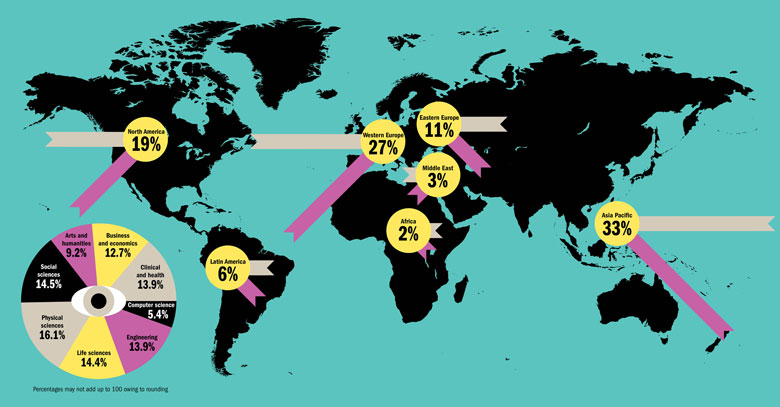Times Higher Education’s annual Academic Reputation Survey, available in 15 languages, uses United Nations data as a guide to ensure the response coverage is as representative of world scholarship as possible. It is also evenly spread across academic disciplines.
The questionnaire, administered on behalf of THE by Elsevier, targets only experienced, published scholars, who offer their views on excellence in research and teaching within their disciplines and at institutions with which they are familiar.
The 2016 survey was carried out between January 2016 and March 2016, and received a total of 10,323 responses from 133 countries. Contact details of scholars are drawn from Elsevier’s extensive database of published journal article authors.
We have worked hard to ensure a balanced spread of responses across the disciplines. The best represented subject was the physical sciences (16 per cent of responses), followed by the social sciences (15 per cent). The life sciences, clinical and health, and engineering each achieved 14 per cent of responses, business and economics 13 per cent, arts and humanities 9 per cent and computer science 5 per cent.
The reputation calculation
We have also achieved a fair distribution of survey responses across the regions. A total of 19 per cent of responses hail from North America. The rest of the responses break down as follows: 33 per cent from the Asia Pacific region, 27 per cent from Western Europe, 11 per cent from Eastern Europe, 6 per cent from Latin America, 3 per cent from the Middle East and 2 per cent from Africa.
Where countries were over- or under-represented, THE’s data team weighted the responses to more closely reflect the actual geographical distribution of scholars, based on United Nations data.
In the survey, scholars are questioned at the level of their specific subject discipline. They are not asked to create a ranking themselves or to list a large range of institutions, but to name no more than 15 universities that they believe are the best in each category (research and teaching), based on their own experience.
The survey data is used alongside 11 objective indicators to help create the Times Higher Education World University Rankings.
请先注册再继续
为何要注册?
- 注册是免费的,而且十分便捷
- 注册成功后,您每月可免费阅读3篇文章
- 订阅我们的邮件
已经注册或者是已订阅?

